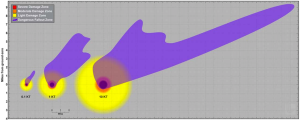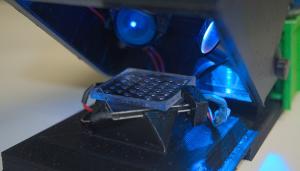LAB REPORT
Science and Technology Making Headlines
March 24, 2017


More than 60 movies of nuclear tests are now available for public viewing.
Rescuing nuclear test films
The cameras shudder as blinding light flashes across the earth. Deformed white clouds balloon and mutate from the force of the nuclear test explosions.
These are some of the images captured in raw footage of bomb tests carried out by the United States between 1945 and 1962 in Nevada and the Marshall Islands. For the first time, the footage is available in an online archive after some of about 10,000 nuclear testing films were restored, scrutinized and declassified in a project by the Lawrence Livermore National Laboratory.
The bulk of the videos, some only seconds long and others just over seven minutes, had been stored at the Los Alamos National Laboratory in New Mexico. But the experts in Livermore, have been working for years to retrieve and preserve the films, which over time had begun to turn brittle or curl, by creating digital imprints.


The purple on this chart designates the dangerous fallout zones from a 0.1 kiloton, a 1 kiloton and a 10 kiloton nuclear bomb.
Duck and cover
Nuclear terrorism and dirty bombs remain a sobering threat. Though these events are unlikely to trigger the last-ditch option of nuclear war, let alone a blast in your neighborhood, they are very concerning.
So you might be wondering, “If I survive a nuclear-bomb attack, what should I do?”
Michael Dillon, a Lawrence Livermore National Laboratory researcher, crunched the numbers and helped figure out just that in a study published in the journal Proceedings of the Royal Society A: Mathematical and Physical Sciences.
Likewise, government agencies and other organizations also have explored the harrowing question and came up with detailed recommendations and response plans.


This handheld diagnostic kit is low-cost, portable, easy to use and can diagnose in about one hour. Photo by Kate Hunts/LLNL
A fight against infection in the palm of your hand
Finding the right treatment plan for patients who have antibiotic-resistant infections is a costly and time-consuming effort. For doctors in rural areas or developing countries, there often is no source of electricity nearby or sterile lab conditions with microbiology specialists on hand. The current standard for bacterial identification is to isolate and grow the species in an assay, which can take hours to weeks.
A research team, including Lawrence Livermore National Laboratory scientists and collaborators from the University of Wisconsin, Madison, developed a diagnostic kit that is low-cost, portable and easy to use.
The kit, about the size of a shoebox, runs on 9 volt batteries with a soft plastic reader called a B-chip (bacteria-detection chip) that performs a recombinase polymerase amplification (RPA) assay in about one hour. The chip uses a disposable plastic assay cartridge with wells that can assess up to 16 different diseases at one time. De-gassed sample solutions self-pump into the inlet, then air is added as a barrier physically separating the reactions into the wells and preventing cross-contamination.


Lawrence Livermore scientists studied low-level stratocumulus clouds to identify their effects on global warming.
Global warming's impact gets cloudy
Clouds play a significant role in Earth’s climate system by reflecting incoming sunlight and reducing outgoing heat. As Earth’s oceans and other surfaces warm, clouds' reaction to light and heat changes.
Lawrence Livermore scientists examined how the changes in the clouds in turn influence the climate system. They showed how cloud variations induced by changes in the areas of warm and cooler sea surface temperatures have contributed to the climate.
They showed that the changes to the clouds have had a cooling effect in response to recent climate change. The study provides the physical mechanism of how the spatial pattern of surface warming affects the magnitude of cloud feedback.


Many components in Formula 1 cars are made of carbon fiber.
A boost for trains, planes and automobiles
The railroad, aerospace and automotive industry could get a boost from new 3D printed aerospace-grade carbon fiber composites developed by Lawrence Livermore researchers.
The research opens the door to greater control and optimization of the lightweight, yet stronger than steel material.
Carbon fiber also has a high resistance to temperature, making the composite material popular in the aerospace, defense and automotive industries, and sports such as surfing and motorcycle racing.
The team printed several complex 3D structures through a modified Direct Ink Writing (DIW) 3D printing process. The researchers also developed and patented a new chemistry that can cure the material in seconds instead of hours, and used the Lab's high performance computing capabilities to develop accurate models of the flow of carbon fiber filaments.





